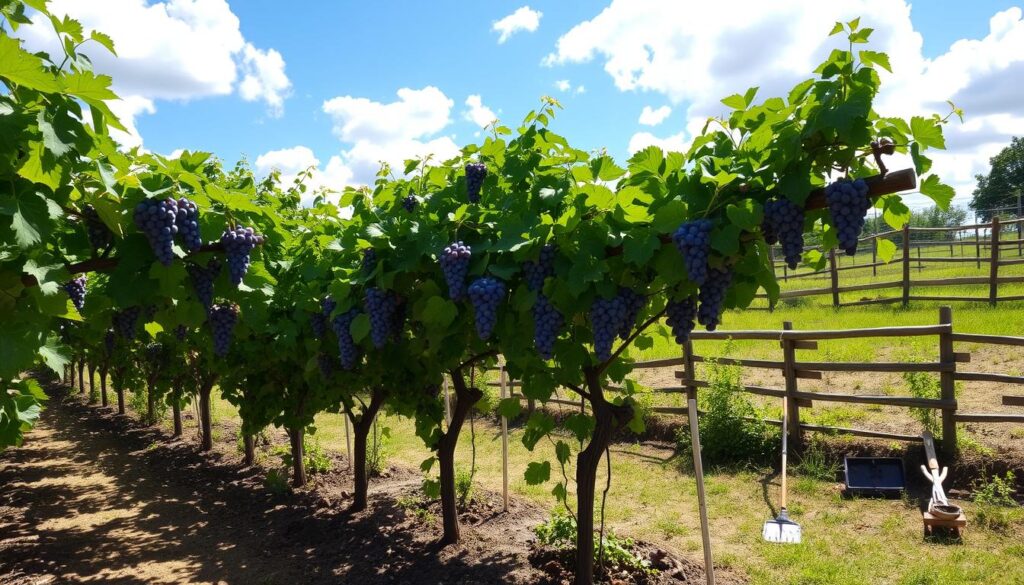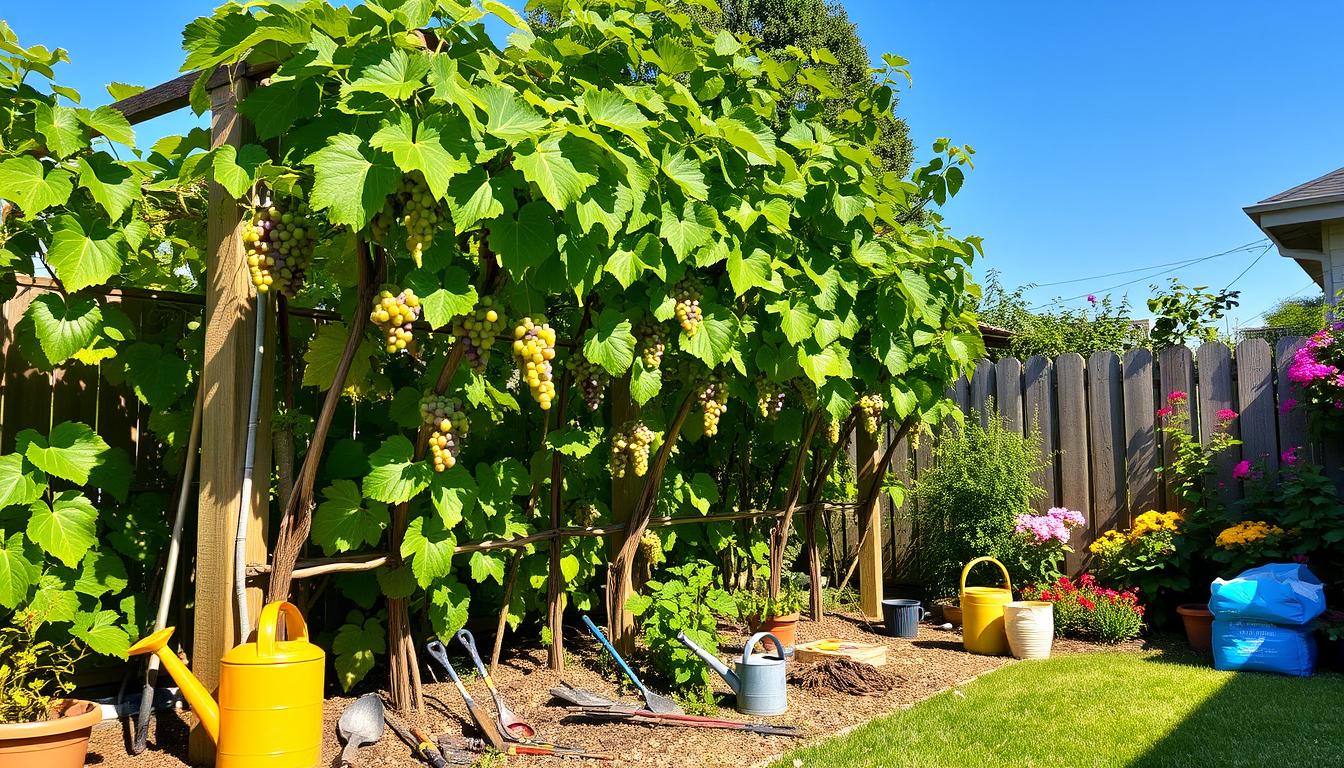Growing grapes in your backyard is a rewarding hobby that brings fresh fruit right to your door. Grapes are versatile, perfect for eating fresh, making juice, or even wine. Starting my journey to grow grapes, I found that with the right care, anyone can do it, no matter their gardening skills.
Learning the basics like choosing the right spot, picking the right variety, and regular care is key. In this article, I’ll share tips and techniques for growing grapes in your backyard. We’ll cover how to grow healthy vines and enjoy the fruits of your labor.
Key Takeaways
- Grapes need full sun to grow well and ripen.
- Each vine needs about 6 feet of space to grow.
- With good care, grapes can produce fruit in as little as one year.
- Pruning every year in spring is vital for healthy grapes.
- Picking the right grape variety for your climate is crucial.
- Watering regularly and using compost are important for young vines.
Understanding the Basics of Grapes
Grapes are fascinating plants that grow as perennial vines. They thrive in many climates, making it easy for gardeners to grow them in their backyards. Grapevines can produce fruit every year if they have the right conditions.
There are different types of grapes, like American, European, and Muscadine. The choice depends on how you want to use them. You might want them for eating fresh, making juice, or creating wine.
Perennial Green Vines
Grapes are long-lasting vines that keep producing fruit. They need lots of sunlight and well-drained soil to grow well. They can grow in USDA zones 4 to 10, covering much of the United States.
It’s important to space them correctly. Each vine needs about 50 to 100 square feet when grown vertically. Horizontally, space rows 8 feet apart for better growth.
Different Uses for Grapes
Grapes are not just for eating. Each type has its own use. American grapes are great for eating fresh, making juice, and jellies. They do well in cooler climates.
European grapes are perfect for winemaking and eating fresh. They prefer warmer, drier areas. Muscadine grapes are known for their quality in the south. They’re often used for jams and wines.
| Type of Grape | Scientific Name | Preferred Climate | Main Uses |
|---|---|---|---|
| American Grapes | Vitis labrusca | Zones 4-7 | Table grapes, juices, jellies |
| European Grapes | Vitis vinifera | Zones 7-10 | Wines, table grapes |
| Muscadine Grapes | Vitis rotundifolia | Zones 7-9 | Wines, jams |
Why You Should Grow Grapes at Home
Growing grapes at home is a great choice for gardeners. Grapes are full of health benefits, making them a great snack. They are also packed with antioxidants, which are good for your heart.
Drinking grape juice can help lower blood pressure. This improves your heart health.
Health Benefits of Grapes
Adding grapes to your meals can boost your health. The main health benefits of grapes include:
- Heart Health: Grapes have flavonoids that help your heart by reducing inflammation and preventing blood clots.
- Antioxidant Power: Grapes are full of antioxidants like resveratrol, which protect cells from damage.
- Hydration: Grapes have a lot of water, helping keep your body hydrated and working well.
Having a grapevine in your backyard is appealing because of these health benefits. Eating fresh grapes is not only tasty but also good for your health.
Cost Efficiency of Backyard Growing
Growing grapes can save you money while giving you tasty results. Here are some reasons why growing grapes at home is cost-effective:
- High Yield: Mature grapevines can produce 15 to 30 pounds of fruit each year, more than store-bought grapes.
- Low Maintenance Costs: Grapevines need little care once they’re set up, saving you money on gardening costs.
- Long Lifespan: Grapevines are long-lasting plants that can produce fruit for many years, making the initial cost worth it.
By growing grapes at home, I get both financial and health benefits. Harvesting fresh grapes whenever I want supports a healthy lifestyle and is a smart gardening choice.
| Health Benefits | Cost Efficiency |
|---|---|
| Rich in antioxidants | High yield potential (15-30 lbs per vine) |
| Improves heart health | Low maintenance gardening costs |
| Hydration benefits | Long lifespan of grapevines |
How to Grow Grapes in Your Backyard
Growing grapes in my backyard has been rewarding. The right location is key for growing these tasty fruits. Grapevines need lots of sunlight and good air flow.
At least seven hours of direct sunlight a day boosts fruit production. This sunlight helps make the grapes sweet.
Choosing the Right Location for Your Grapevines
When picking a spot for grapevines, several factors matter. The soil should drain well and protect from strong winds. A big enough area is needed for the vines to grow and get air.
Community gardens show that grapevines need space. Even in small areas, enough room is crucial. This is important for space requirements for grapevines.
Space Requirements: What You Need to Know
Each grapevine needs about 50 to 100 square feet. This space helps them grow up when supported. Between rows, keep 8 feet for easy access and air flow.
For good grape growing, check local garden centers for the right varieties. Use growing tips and advice to help from start to finish.

| Factor | Requirements |
|---|---|
| Sunlight | 7 hours of direct sunlight |
| Soil | Well-drained, moist |
| Space per vine | 50 to 100 square feet |
| Row spacing | 8 feet between rows |
| Support Height | 6 feet or taller for trellises |
For new gardeners, online resources like gardening guides are helpful. With the right info and tools, growing grapevines in your backyard is easy and rewarding.
Selecting the Best Grape Varieties
Choosing the right grape varieties is all about knowing the different types and what climate they need. I look at the grape’s traits and my growing area’s conditions. This way, I pick plants that will do well and give me great harvests.
Types of Grapes: American, European, and Muscadine
There are three main types of grapevines I consider:
- American Grapes (Vitis labrusca): These are the most cold-hardy, doing well in USDA zones 4-7. They love cooler temperatures and short growing seasons. Concord and Niagara are favorites.
- European Grapes (Vitis vinifera): These are best for making wine, needing zones 7-10. They need a long growing season and can handle mild winters. Cabernet Sauvignon and Chardonnay are common choices.
- Muscadine Grapes (Vitis rotundifolia): Perfect for the humid south (zones 7-9), they taste great and are good for wine. Their unique flavor and texture make them stand out.
Climate Considerations for Grape Varieties
Knowing what climate each grape variety needs is crucial. For example, American grapes do well in cooler places, while European grapes need warm summers. Here’s what I keep in mind:
- American grapes like moderate summer heat and can handle temperatures as low as -20°F.
- European grapes can take high heat and cold down to 5°F but are more prone to diseases.
- Muscadine grapes love humid, warm places with long growing seasons, perfect for the south.
By picking grape varieties that fit the climate, I make sure my backyard vineyard thrives. This way, my grapes will flourish.
Preparing the Soil for Grapes
Getting the soil right is key for a successful vineyard. Grapes grow well in many soils, like clay and sand, as long as water drains well. Knowing the soil type is important for the health and growth of grapevines.
Soil Composition and pH Levels
The soil’s pH level is crucial for grape growth. It should be between 6.0 and 6.8. The soil needs to be at least 30 inches deep because grapevines have deep roots.
Loosening the soil helps roots grow better. It’s also important to test the soil for minerals and nutrients before planting. This ensures the soil is balanced for the grapes.
Amending Soil for Optimal Growth
Adding nutrients to the soil is vital for grape growth. Use compost, sand, manure, lime, and peat moss for this. Compost helps keep the soil moist and rich in nutrients.
Studies show that using well-rotted manure can increase fruit yield by up to 30%. You can amend the soil at any time when it’s not wet or frozen.
Using the right soil amendments helps roots grow faster and vines thrive. Spending time on soil preparation leads to a better harvest. For more information, check out this link.
Planting Your Grapevines Effectively
Planting grapevines needs careful planning and timing. The best time is early spring after the frost. This ensures they grow well. A step-by-step guide makes planting easy and fun.
Timing for Planting Grapes
The best time to plant grapes is early spring when the ground thaws. This lets the vines grow strong before summer. Grapevines do well in USDA zones 4-10, fitting many US climates. Make sure they get enough sunlight and avoid late frosts.
Step-by-Step Planting Instructions
To plant grapevines successfully, I follow a detailed method:
- Soak bare-root vines in water for at least an hour to hydrate.
- Choose a sunny location that receives 7 to 8 hours of direct sunlight daily.
- Dig a hole approximately two feet deep and wide to accommodate the roots, which can extend deep into the ground.
- Place the root system carefully into the hole, ensuring that the lowest bud sits just above the soil line.
- Cover the roots gently with soil, avoiding any heavy compaction.
- Water the newly planted grapevines deeply to help settle the soil around the roots.

By following this guide, grapevines will grow healthily. This care in the beginning leads to a fruitful harvest later. It’s the start of a thriving grapevine that will yield lots of grapes.
| Step | Action |
|---|---|
| 1 | Soak bare-root vines |
| 2 | Choose a sunny location |
| 3 | Dig a hole 2 feet deep and wide |
| 4 | Place root system in the hole |
| 5 | Cover roots with soil |
| 6 | Water freshly planted vines |
Backyard Grapevine Maintenance
Maintaining grapevines is key for a good harvest. It involves the right watering and fertilizing. These steps help vines grow well and produce lots of fruit.
Watering Techniques for Grapevines
Consistency is important when watering grapevines. Young vines need about 5 gallons of water each week. I avoid overhead watering to prevent fungal diseases.
Instead, I use drip or soak watering at the base. This method helps roots grow deep and keeps the soil just right.
Managing Nutrient Needs: Fertilization Tips
Fertilizing grapes needs careful thought. In spring, I use a balanced fertilizer and organic compost. This supports strong vine growth.
I use 8 to 10 ounces of 10-10-10 or 10-20-20 fertilizer per plant. Regular soil checks help adjust nutrients. This prevents any shortages. Soil pH should be between 5.0 and 6.5 for best health.
| Nutrient | Amount (ounces) | Timing |
|---|---|---|
| 10-10-10 Fertilizer | 8-10 | Early Spring |
| Compost | Layer Around Base | Early Spring |
| Watering | 5 gallons | Weekly (First Two Seasons) |
These maintenance steps keep my vines healthy. They’re ready for a big harvest next season. The right watering and fertilizing are essential for thriving vines.
Understanding Grapevine Pruning
Grapevine pruning is key for your grapevines’ health and productivity. It manages growth and boosts fruit yield. Knowing when and how to prune grapes can greatly improve your harvest.
When to Prune Your Grapevines
The best time to prune grapevines is from January to March, when they’re dormant. Pruning before new growth starts helps the vines focus on existing vines. It’s important to cut off 80% to 90% of last year’s growth. This makes room for new shoots and better fruit clusters.
Pruning Techniques for Healthier Vines
I use two main pruning methods: cane and spur pruning. Cane pruning picks canes with 8 to 16 buds and about pencil thickness for more fruit. Spur pruning keeps the main trunk and some branches, with new shoots from spurs along the trunk.
These methods work well for different grape types. American grapes do well with cane pruning. Many European grapes can be pruned either way, improving plant health and fruit quality.
Good pruning not only increases fruit but also keeps the vine healthy. My aim is to balance growth and fruit for better harvests. For more on privacy, see this link.
| Pruning Technique | Description | Best For |
|---|---|---|
| Cane Pruning | Involves leaving canes with 8-16 buds, removes most of the previous growth | Most American grapes |
| Spur Pruning | Permanently maintains a trunk with canes growing from spurs | Many European grape varieties |
Dealing with Common Pests and Diseases
When I grow grapes in my backyard, I see that they face many pests and diseases. Aphids, grape berry moths, and powdery mildew are big threats. Spotting these problems early is key.
By checking my vines often, I can catch signs like discolored leaves. This lets me act fast to stop infestations.
Identifying Key Threats to Grapevines
Many pests and diseases can harm grape quality and yield. Aphids damage vines by sucking sap. Grape berry moths ruin fruit.
Diseases like Grape Phylloxera and Botrytis Bunch Rot can destroy a harvest. Knowing these threats helps me protect my grapes.
Organic Methods for Pest Control
Using organic pest control works well for me. I bring in ladybugs to eat aphids. Nets keep birds away from grapes.
I also use organic sprays to keep pests off without harming the environment. Watching my vines closely helps me keep them healthy and productive.



Leave a Reply